The firstlawofthermody namics The first law of

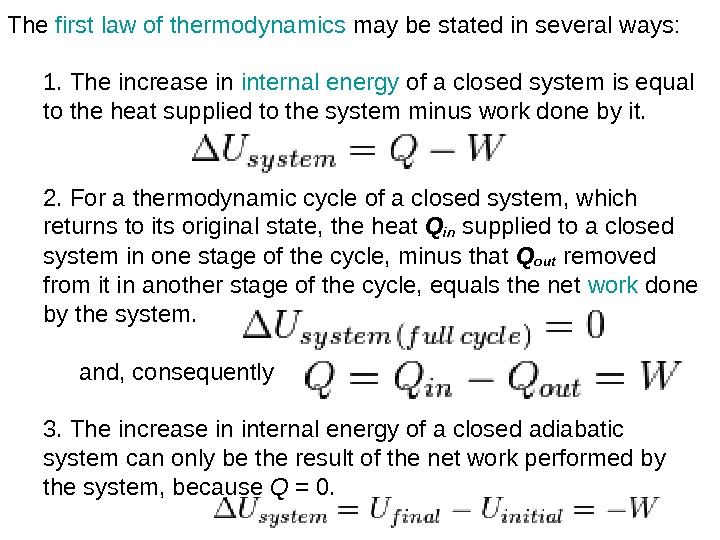
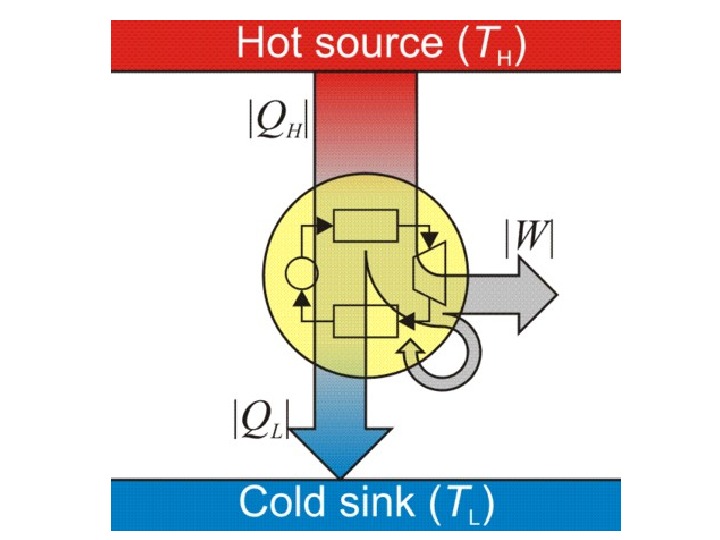
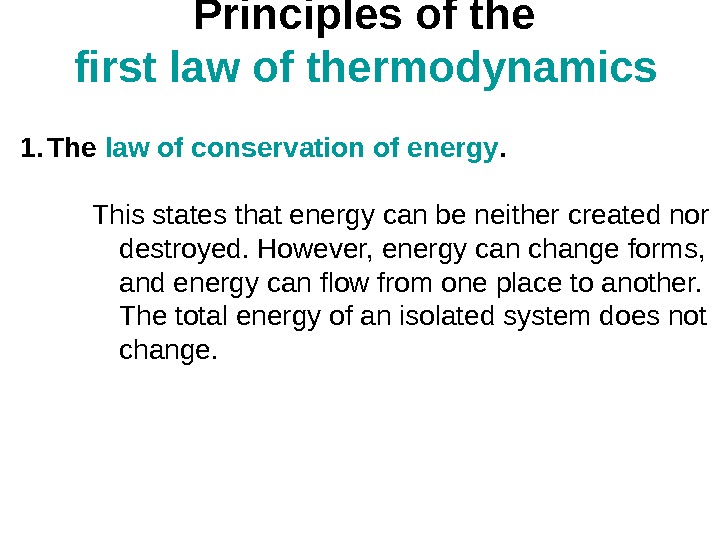

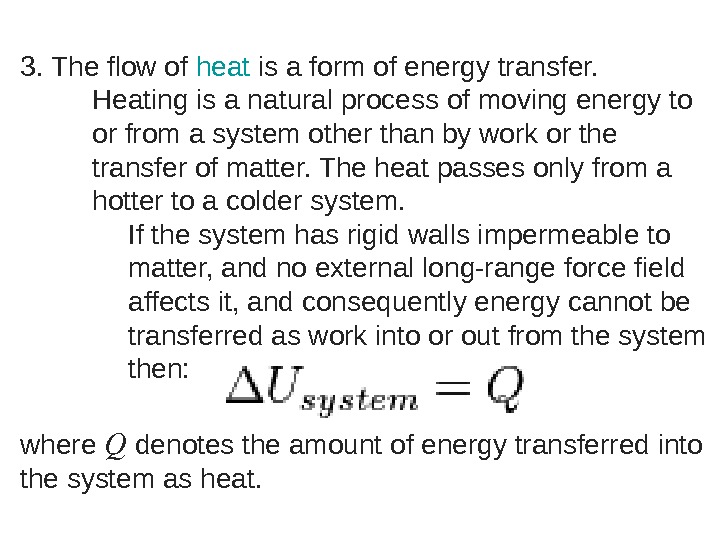
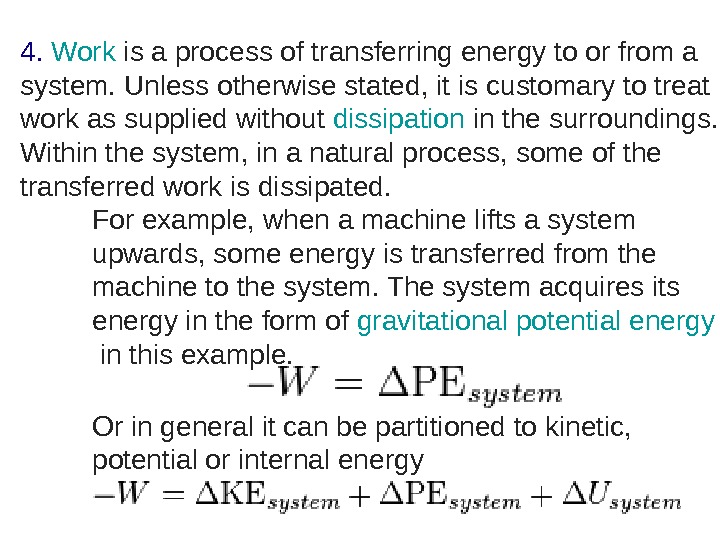
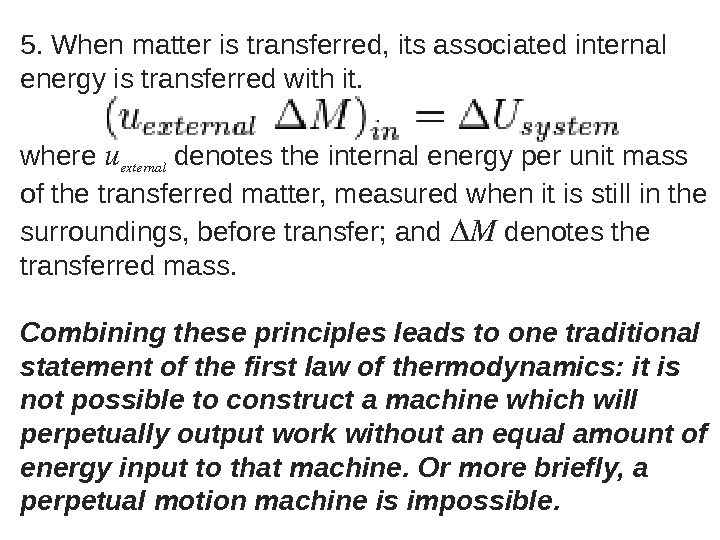


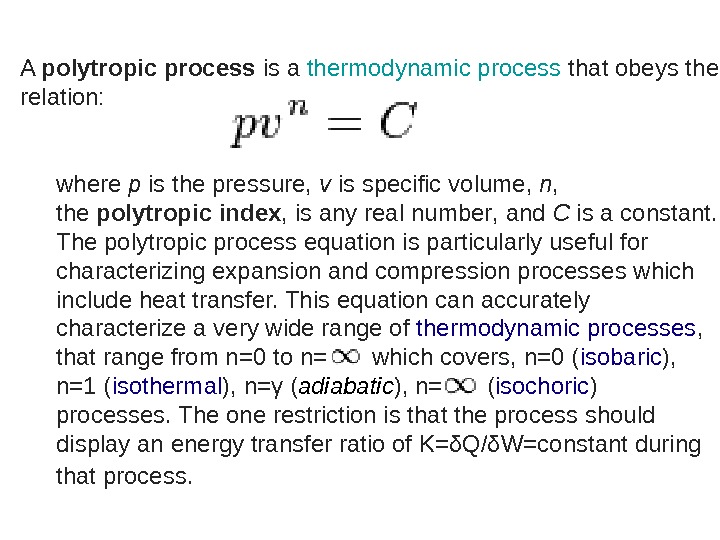
- Размер: 230 Кб
- Количество слайдов: 11
Описание презентации The firstlawofthermody namics The first law of по слайдам
 The firstlawofthermody namics
The firstlawofthermody namics
 The first law of thermodynamics may be stated in several ways: 1. The increase in internal energy of a closed system is equal to the heat supplied to the system minus work done by it. 2. For a thermodynamic cycle of a closed system, which returns to its original state, the heat Q in supplied to a closed system in one stage of the cycle, minus that Q out removed from it in another stage of the cycle, equals the net work done by the system. and, consequently 3. The increase in internal energy of a closed adiabatic system can only be the result of the net work performed by the system, because Q = 0.
The first law of thermodynamics may be stated in several ways: 1. The increase in internal energy of a closed system is equal to the heat supplied to the system minus work done by it. 2. For a thermodynamic cycle of a closed system, which returns to its original state, the heat Q in supplied to a closed system in one stage of the cycle, minus that Q out removed from it in another stage of the cycle, equals the net work done by the system. and, consequently 3. The increase in internal energy of a closed adiabatic system can only be the result of the net work performed by the system, because Q = 0.

 P rinciples oft he firstlawofthermodynamics 1. The lawofconservationofenergy. This states that energy can be neither created nor destroyed. However, energy can change forms, and energy can flow from one place to another. The total energy of an isolated system does not change.
P rinciples oft he firstlawofthermodynamics 1. The lawofconservationofenergy. This states that energy can be neither created nor destroyed. However, energy can change forms, and energy can flow from one place to another. The total energy of an isolated system does not change.
 2. The concept of internal energy and its relationship to temperature. If a system has a definite temperature, then its total energy has three distinguishable components. a) If the system is in motion as a whole, it has kinetic energy. b) If the system as a whole is in an externally imposed force field (e. g. gravity), it has potential energy relative to some reference point. c) Finally, it has internal energy, which is a fundamental quantity for thermodynamics. Beyond the conceptual frame of macroscopic thermodynamics, it can be explained as the sum of the disorganized kinetic energy of microscopic motions of its constituent atoms, and of the potential energy of interactions between them. Other things being equal, the kinetic energy of microscopic motions of the constituent atoms increases as the system’s temperature increases. The establishment of the concept of internal energy is the characteristic distinguishing feature of the first law of thermodynamics.
2. The concept of internal energy and its relationship to temperature. If a system has a definite temperature, then its total energy has three distinguishable components. a) If the system is in motion as a whole, it has kinetic energy. b) If the system as a whole is in an externally imposed force field (e. g. gravity), it has potential energy relative to some reference point. c) Finally, it has internal energy, which is a fundamental quantity for thermodynamics. Beyond the conceptual frame of macroscopic thermodynamics, it can be explained as the sum of the disorganized kinetic energy of microscopic motions of its constituent atoms, and of the potential energy of interactions between them. Other things being equal, the kinetic energy of microscopic motions of the constituent atoms increases as the system’s temperature increases. The establishment of the concept of internal energy is the characteristic distinguishing feature of the first law of thermodynamics.
 3. The flow of heat is a form of energy transfer. Heating is a natural process of moving energy to or from a system other than by work or the transfer of matter. The heat passes only from a hotter to a colder system. If the system has rigid walls impermeable to matter, and no external long-range force field affects it, and consequently energy cannot be transferred as work into or out from the system then: where Q denotes the amount of energy transferred into the system as heat.
3. The flow of heat is a form of energy transfer. Heating is a natural process of moving energy to or from a system other than by work or the transfer of matter. The heat passes only from a hotter to a colder system. If the system has rigid walls impermeable to matter, and no external long-range force field affects it, and consequently energy cannot be transferred as work into or out from the system then: where Q denotes the amount of energy transferred into the system as heat.
 4. Work is a process of transferring energy to or from a system. Unless otherwise stated, it is customary to treat work as supplied without dissipation in the surroundings. Within the system, in a natural process, some of the transferred work is dissipated. For example, when a machine lifts a system upwards, some energy is transferred from the machine to the system. The system acquires its energy in the form of gravitational potential energy in this example. Or in general it can be partitioned to kinetic, potential or internal energy
4. Work is a process of transferring energy to or from a system. Unless otherwise stated, it is customary to treat work as supplied without dissipation in the surroundings. Within the system, in a natural process, some of the transferred work is dissipated. For example, when a machine lifts a system upwards, some energy is transferred from the machine to the system. The system acquires its energy in the form of gravitational potential energy in this example. Or in general it can be partitioned to kinetic, potential or internal energy
 5. When matter is transferred, its associated internal energy is transferred with it. where u external denotes the internal energy per unit mass of the transferred matter, measured when it is still in the surroundings, before transfer; and Δ M denotes the transferred mass. Combining these principles leads to one traditional statement of the first law of thermodynamics: it is not possible to construct a machine which will perpetually output work without an equal amount of energy input to that machine. Or more briefly, a perpetual motion machine is impossible.
5. When matter is transferred, its associated internal energy is transferred with it. where u external denotes the internal energy per unit mass of the transferred matter, measured when it is still in the surroundings, before transfer; and Δ M denotes the transferred mass. Combining these principles leads to one traditional statement of the first law of thermodynamics: it is not possible to construct a machine which will perpetually output work without an equal amount of energy input to that machine. Or more briefly, a perpetual motion machine is impossible.
 An isothermalprocess is a change of a system , in which the temperture remains constant: Δ T = 0. This typically occurs when a system is in contact with an outside thermal reservoir ( heat bath ), and the change occurs slowly enough to allow the system to continually adjust to the temperature of the reservoir through heat exchange. In contrast, an adiabatic process is where a system exchanges no heat with its surroundings ( Q = 0). In other words, in an isothermal process, the value Δ T = 0 and therefore Δ U = 0 (only for an ideal gas) but Q ≠ 0, while in an adiabatic process, Δ T ≠ 0 but Q = 0.
An isothermalprocess is a change of a system , in which the temperture remains constant: Δ T = 0. This typically occurs when a system is in contact with an outside thermal reservoir ( heat bath ), and the change occurs slowly enough to allow the system to continually adjust to the temperature of the reservoir through heat exchange. In contrast, an adiabatic process is where a system exchanges no heat with its surroundings ( Q = 0). In other words, in an isothermal process, the value Δ T = 0 and therefore Δ U = 0 (only for an ideal gas) but Q ≠ 0, while in an adiabatic process, Δ T ≠ 0 but Q = 0.
 An isobaric process is a thermodynamic process in which the pressure stays constant: Δ P = 0. The term derives from the Greek iso- (equal) and baros (weight). The heat transferred to the system does work, but also changes the internal energy of the system: An isochoricprocess , also called a constant-volumeprocess , is a thermodynamic process during which the volume of the closed system undergoing such a process remains constant. An isochoric process is exemplified by the heating or the cooling of the contents of a sealed, inelastic container.
An isobaric process is a thermodynamic process in which the pressure stays constant: Δ P = 0. The term derives from the Greek iso- (equal) and baros (weight). The heat transferred to the system does work, but also changes the internal energy of the system: An isochoricprocess , also called a constant-volumeprocess , is a thermodynamic process during which the volume of the closed system undergoing such a process remains constant. An isochoric process is exemplified by the heating or the cooling of the contents of a sealed, inelastic container.
 A polytropicprocess is a thermodynamic process that obeys the relation: where p is the pressure, v is specific volume, n , the polytropicindex , is any real number , and C is a constant. The polytropic process equation is particularly useful for characterizing expansion and compression processes which include heat transfer. This equation can accurately characterize a very wide range of thermodynamic processes , that range from n=0 to n= which covers, n=0 ( isobaric ), n=1 ( isothermal ), n=γ ( adiabatic ), n= ( isochoric ) processes. The one restriction is that the process should display an energy transfer ratio of K=δQ/δW=constant during that process.
A polytropicprocess is a thermodynamic process that obeys the relation: where p is the pressure, v is specific volume, n , the polytropicindex , is any real number , and C is a constant. The polytropic process equation is particularly useful for characterizing expansion and compression processes which include heat transfer. This equation can accurately characterize a very wide range of thermodynamic processes , that range from n=0 to n= which covers, n=0 ( isobaric ), n=1 ( isothermal ), n=γ ( adiabatic ), n= ( isochoric ) processes. The one restriction is that the process should display an energy transfer ratio of K=δQ/δW=constant during that process.
